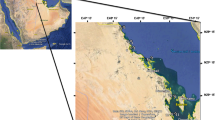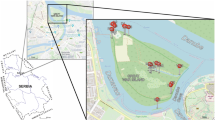Abstract
Shallow surface sediment samples from the Mesopotamian marshlands of Iraq were collected and analyzed to determine the distribution, concentrations and sources of aliphatic lipid compounds (n-alkanes, n-alkanols, n-alkanoic acids, and methyl n-alkanoates) and molecular markers of petroleum in these wetlands. The sediments were collected using a stainless steel sediment corer, dried, extracted with a dichloromethane/methanol mixture and then analyzed by gas chromatography-mass spectrometry (GC–MS). The aliphatic lipid compounds included n-alkanes, n-alkanoic acids, n-alkanols and methyl n-alkanoates with concentrations ranged from 6.8 to 31.1 μg/g, 4.1 to 5.0 μg/g, 5.9 to 7.7 μg/g and from 0.3 to 5.9 μg/g, respectively. The major sources of aliphatic lipids were natural from waxes of higher plants (24–30%) and microbial residues (42–30%), with a significant contribution from anthropogenic sources (27–30%, petroleum), based on the organic geochemical parameters and indices. Further studies are needed to characterize the rate, accumulation and transformation of various organic matter sources before and after re-flooding of these wetlands.







Similar content being viewed by others
References
Abas MRB, Simoneit BRT (1998) Wax lipids from leaf surfaces of some common plants of Malaysia. Pertanika J Sci Technol 6:171–182
Al-Saaidi HA, Antoin SE, Nurul-Islam AKM (1981) Limnology investigation in Al-Hammar Marsh area in Southern Iraq. Nova Hedweigia 35:157–169
Bendoraitis JG, Brown BL, Hepner LS (1962) Isoprenoid hydrocarbons in petroleum. Isolation of 2,6,10,14-tetramethylpentadecane by high temperature gas-liquid chromatography. Anal Chem 34:49–53
Bird CW, Lynch JM (1974) Formation of hydrocarbons by micro-organisms. Chem Soc Rev 3:309–328
Brasington J (2002) The Iraqi marshlands: a human and environmental study. In: Nicholson E, Clark P (eds) Politics Publishing, London
Davis JB (1968) Paraffinic hydrocarbons in the sulfate-reducing bacterium Desulfovibrio desulfuricans. Chem Geol 3:155–160
Debyser Y, Pelet R, Dastillung M (1977) Organic geochemistry of recent marine sediments: Black Sea, Baltic Sea, Atlantic (Mauritania), Adv Org Geochem 1975, Proc Int Meet 7th (1977), Meeting Date 1975, Madrid, Enadimsa, p 289
Didyk BM, Simoneit BRT, Brassell SC, Eglinton G (1978) Organic geochemical indicators of palaeoenvironmental conditions of sedimentation. Nature 272:216–222
DouAbul A, Al-Saad H, Al-Timari A, Al-Rakabi H (1988) Tigris–Euphrates Delta: a major source of pesticides to the Shatt al-Arab River (Iraq). Arch Environ Contam Toxicol 17:405–418
Eglinton G, Hamilton RJ (1967) Leaf epicuticular waxes. Science 156:1322–1335
Grimalt J, Albaiges J, Al-Saad HT, DouAbul AAZ (1985) n-Alkanes distribution in surface sediments from the Arabian Gulf. Naturwissenschaften 72:S35–S37
Ikan R, Baedecker MJ, Kaplan IR (1975) Thermal alteration experiments on organic matter in recent marine sediment-II. Isoprenoids. Geochim Cosmochim Acta 39:187–194
Kolattukudy PE, Croteau R, Buckner JS (1976) Biochemistry of plant waxes. In: Kolattukudy PE (ed) Chemistry and biochemistry of natural waxes. Elsevier, Amsterdam
Lawler A (2005) Reviving Iraq’s wetlands. Science 307:1186–1189
Maltby E (ed) (1994) An environmental and ecological study of the marshlands of Mesopotamia. Draft Consultive Bulletin, AMAR Appeals Trust, London, pp 224
Maxwell JR, Pillinger CT, Eglinton G (1971) Organic geochemistry. Chem Soc Q Rev 25:571–628
Mazurek MA, Cass GR, Simoneit BRT (1991) Biological input to visibility-reducing aerosol particles in the remote arid Southwestern United States. Environ Sci Technol 25:684–694
Partow H (2001) Demise of an ecosystem: the disappearance of the Mesopotamian Marshlands United Nations Environment Program (UNEP). Publication UNEP/DEWA/TR. 01–3, Nairobi, Kenya
Peters KE, Moldowan JM (1993) The Biomarker guide: interpreting molecular fossils in petroleum and ancient sediments. Prentice Hall, Englewood Cliffs
Richardson CJ, Reiss P, Hussain NA, Alwash AJ, Pool DJ (2005) The restoration of potential of the Mesopotamian marshes of Iraq. Science 307:1307–1311
Rogge WF, Mazurek MA, Hildemann LM, Cass GR, Simoneit BRT (1993) Quantification of urban organic aerosols at a molecular level: identification, abundance and seasonal variation. Atmos Environ 27A:1309–1330
Rushdi AI, Al-Zarban S, Simoneit BRT (2006) Chemical compositions and sources of organic matter in fine particles of soils and sands from the vicinity of Kuwait city. Environ Monit Assess (in press)
Salim SM (1962) Marsh dwellers of the Euphrates Delta. University of London, Athlone Press, London
Simoneit BRT (1977) Organic matter in eolian dusts over the Atlantic Ocean. Mar Chem 5:443–464
Simoneit BRT (1978) The organic chemistry of marine sediments. In: Riley JP, Chester R (eds) Chemical oceanography, 2nd edn. Academic, New York
Simoneit BRT (1984) Organic matter of the troposphere-III. Characterization and sources of petroleum and pyrogenic residues in aerosols over the Western United States. Atmos Environ 18:51–67
Simoneit BRT (1985) Application of molecular marker analysis to vehicular exhaust for source reconciliation. Int J Environ Anal Chem 22:203–233
Simoneit BRT (2002) Biomass burning—a review of organic tracers from smoke from incomplete combustion. Appl Geochem 17:129–162
Simoneit BRT, Mazurek MA (1982) Organic matter of the troposphere-II. Natural background of biogenic lipid matter in aerosols over the rural Western United States. Atmos Environ 16:2139–2159
Simoneit BRT, Mazurek MA, Brenner S, Crisp PT, Kaplan IR (1979) Organic geochemistry of recent sediments from Guaymas Basin, Gulf of California. Deep Sea Res 26A:879–891
Stephanou EG, Stratigakis NE (1993) Determination of anthropogenic and biogenic organic compounds on airborne particles: flash chromatographic fractionation and capillary gas chromatographic analysis. J Chromatogr 644:141–151
Talling JF (1980) Water characteristics. In: Rzoska J (ed) Euphrates and Tigris, the Mesopotamian ecology and density. W. Jank, The Hague, Boston and London, p 122
Thesiger W (1985) The marsh Arabs. Collins, London
Young G (1983) Return to the marshes: life with the marsh Arabs of Iraq. Hutchinson, London
Acknowledgement
The authors would like to extend their gratitude to Dr. Azzam Al-Wash, Project Director, Eden Again Project, for his support and encouragement.
Author information
Authors and Affiliations
Corresponding author
Rights and permissions
About this article
Cite this article
Rushdi, A.I., DouAbul, A.A., Mohammed, S.S. et al. Compositions and sources of extractable organic matter in Mesopotamian marshland surface sediments of Iraq. I: aliphatic lipids. Environ Geol 50, 857–866 (2006). https://doi.org/10.1007/s00254-006-0257-6
Received:
Accepted:
Published:
Issue Date:
DOI: https://doi.org/10.1007/s00254-006-0257-6




